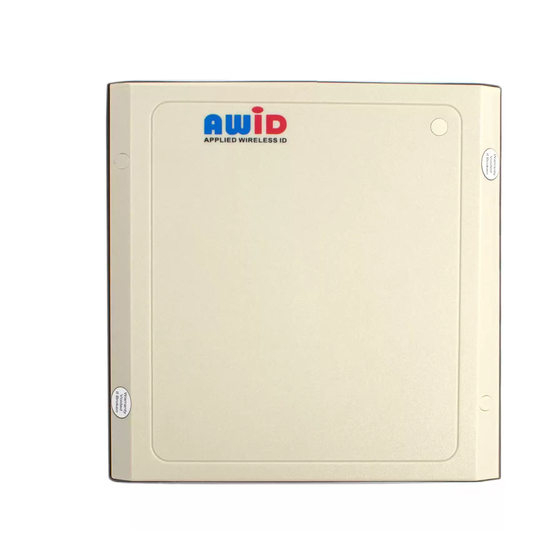
Table of Contents
Advertisement
Quick Links
APPLIED WIRELESS ID
These notes are for AWID's LR-2000, LR-2200 and LR-3000 reader models, and their "HiLo" variations.
CONTENTS
Section A. Purpose
Section B. Guidelines
Section C. Good Practices
Section D. Tools and Supplies
A.
PURPOSE
While preparing to install AWID's UHF long-range readers and credentials, the steps below will guide the installers.
To start a new project, see AWID's "Support 1 – Getting Started". It helps to assure that the correct products are ordered
and collected for the client's application.
B.
GUIDELINES
1. First thing – Know the client's
2. Study the site's layout. Make plan drawings. Get architect's prints. Take photographs.
3. Define the
roadway
4. A vehicle-length between the reader and the gate may allow the
5. Ideal
vehicle speed
6. If possible, select a reader location where the vehicles travel in a
7. Know
where to mount
8. Plan on
reader height
9. Assure that there is
10. If vehicles will have access to more than one gate, the arrangement of reader and tag locations must be consistent.
11. Mount the reader using an
12. At the reading distance, have the
13. Watch for conditions that may require the
14. Scan the site for
UHF Long-Range Readers – Preparing for Install Support
18300 Sutter Blvd., Morgan Hill, CA 95037 · Voice 408-825-1100 · Fax 408-782-7402 www.awid.com
UHF Long-Range Readers
Support 2 – Preparing to Install
Section E. Documents for Reference
Section F. Testing the Site
Section G. Shop-Testing Products
Section H. Clues for Good Testing
goals and
so that all vehicles follow the same path – one lane wide. Mark the lane if necessary.
may be 15 miles per hour. This should assure time for reliable reading of all tags.
the reader – at the side of the roadway, or above the roadway, or facing turning vehicles.
that relates to the physical structure, vehicle types, tag type and location on vehicles.
between the reader and the tags – no fence, bushes, structure to block the UHF.
open space
adjustable-head
reader and tags aligned
that might affect reading. Use the Installation Kit's "ProHunter" RF Signal Detector.
radiation
Applied Wireless Identifications Group, Inc.
desires. Know what will work, and what needs to be changed.
gate to open
bracket. The reader must be aimed at the location of tags for reading.
with each other – facing each other, in parallel planes.
"HiLo"
dual-antenna reader set, or a protective
Version 1
Section I.
Check List
Section J. Support People
Section K. Hook-Up Diagrams
before vehicles roll up to the gate.
straight line
as the tags are read.
housing
for readers.
Page 1 of 4
Advertisement
Table of Contents

Summary of Contents for AWID LR-2000
- Page 1 While preparing to install AWID’s UHF long-range readers and credentials, the steps below will guide the installers. To start a new project, see AWID’s “Support 1 – Getting Started”. It helps to assure that the correct products are ordered and collected for the client’s application.
- Page 2 1. Use only overall shielded cable (100% rated) for reader’s power and data, and for door locks and gate operators. 2. A reader’s power and data may share the same cable, or run in separate cables. Use AWID’s cable specifications.
- Page 3 SHOP-TESTING AWID’S PRODUCTS When the AWID products arrive, open the packages, account for all items, and know the purpose of each item. Before taking them to the site for installation, use the Installation Kit to see the reader, the tags, the power supply, and other system components working in the friendly environment of your own shop.
- Page 4 Technical Support with questions. AWID’S SUPPORT PEOPLE Sales Please contact your AWID supplier or the Regional Sales Manager. Please contact AWID’s corporate offices – 408-825-1100, option 3. Customer Support Please contact AWID’s corporate offices – 408-825-1100, option 1. Technical Support HOOK-UP DIAGRAMS Figure 1.



Need help?
Do you have a question about the LR-2000 and is the answer not in the manual?
Questions and answers